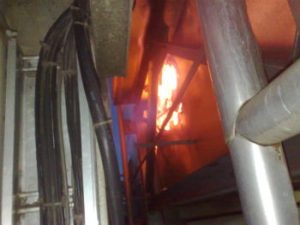CASE STUDY
Metal Fire in Airheater of Biomass Boiler
| PLANT LOCATION | Asia |
| FACILITY DESCRIPTION | Wood Processing |
| BOILER TYPE | Bi Drum – Natural Circulation – Firing |
| BOILER CAPACITY | 40 [Tonnes/hour] |
| STEAM CONDITIONS | 55 [Bar] @ 400 [°C] |
Conditions:

Design Boiler was engaged to investigate the cause of a metal fire in a wood fired boiler that had destroyed its airheater. The fire effectively shut the plant down for over 12 months. A metal fire is one of the most extreme operational hazards likely to be encountered within a boiler. Once inititiated they can be extremely difficulty to extinguish and they have the capacity to destroy an entire boiler in a very short period of time. Although metal fires are commonly associated with boilers firing fuel oil, they can also be encountered on boilers firing solid fuels such as biomass.
Metal fires are caused by a chain reaction initiated by a small intense fire usually resulting from the ignition of a build-up of combustible material. They are normally confined to the back end of the boiler. They are sometimes intensified by water or steam sourced from a burst economizer tube or a leaking sootblower which can disassociate hydrogen from water molecules and trigger an intense hydrogen fire that is hot enough to combust steel tubing. Metal fires can be tremendously destructive and extremely difficult to bring under control.
Design Boiler undertook a design assessment of the effected boiler and identified a number of significant design defects in the airheater that contributed to the fire. These included (a) incorrect tube orientation and gas/air flow configuration, (b) inadequate tube spacing; and (c) excessively small tube diameters. Significant shortcomings with the sootblowers which rendered them largely ineffective were also identified.
Analysis of the combustion system identified a number of additional deficiencies that also contributed to the cause of the fire. Poor combustion resulted in the production of a significant amount of combustible tar and wood resin that carried over and condensed onto airheater tubes and subsequently ignited.
A better understanding of the mechanisms causing fires, along with the implementation of effective operating procedures, has enabled boiler designers to incorporate effective prevention strategies that have in past years, reduced the risk of metal fires. However the increasing popularity of biomass boilers with fuels that can be difficult to burn and which can produce sticky tars and resins that adhere to downstream heating surfaces, has in recent years, resulted in an increased risk of metal fires. In essence the tars produced from biomass, particularly certain species of timber, can have a similar effect to that of oil residue.
The best way to reduce the risk of a metal fires in biomass fired boilers is to ensure that the entire steam generation system is properly designed. Effective combustion, correct airheater design and adequate sootblowing facilities all reduce the probability of a metal fire from occurring. It is also essential that boiler controls can quickly detect the onset of a metal fire and that effective fire extinction strategies are in place to extinguish it. Attempting to extinguish a metal fire with water can, under certain circumstances, supply it hydrogen fuel and intensify it, so it is important that operators are adequately trained on how to manage and extinguish metal fires with appropriate procedures.
